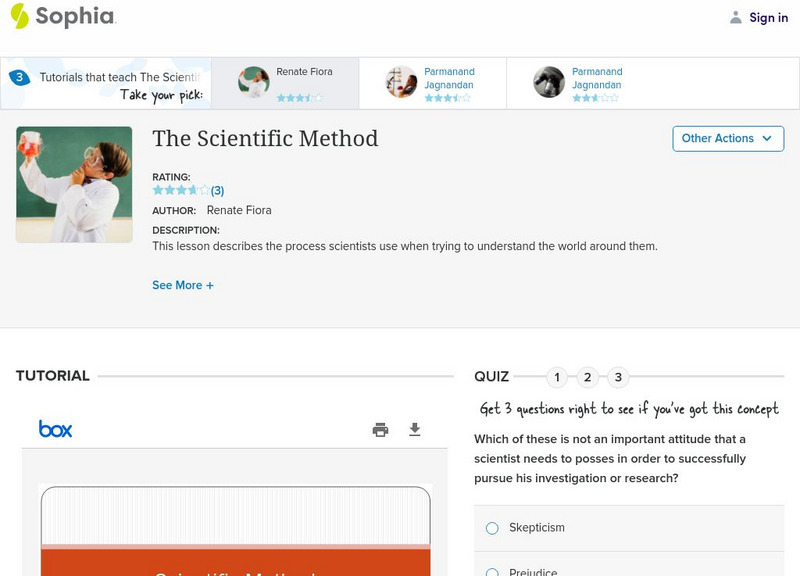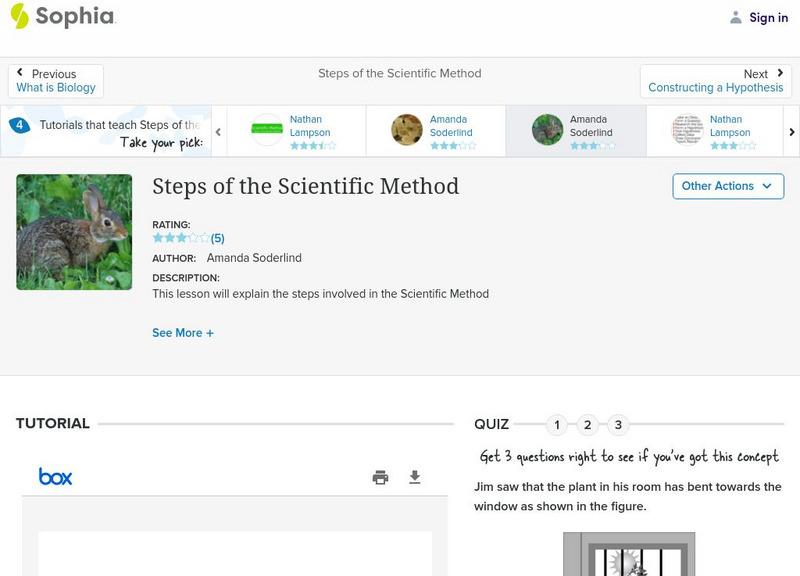Curated OER
Steps of the Scientific Method
Steps of the scientific method are summarized, and then an example experiment is presented to allow practice identifying the steps. The graphics and animations are a little blurry, but this otherwise well-formulated presentation will...
Biology Junction
Scientific Method
Break down the scientific method to get a better grasp on the proper way to use it. A short presentation walks through each step in the scientific method and the proper vocabulary associated with each. Scholars complete the worksheet to...
Mr. E. Science
The Scientific Method
The scientific method is key to implementing tests and experiments. From stating the problem to arriving at the conclusion, every scientist in the class learns the value of the method through an educational slide show presentation.
Curated OER
The Scientific Method
If the steps that you follow for the scientific method are as follows, this presentation can be useful: observation, question, hypothesis, method, result. Unfortunately, not every scientist or teacher uses the same terminology, The...
Curated OER
Science Jeopardy
Make reviewing evolution, cell division, genetics, cell structure, and scientific method more fun! Science Jeopardy allows teams to choose a category for the question they will address. If you complete the entire game, learners will have...
Curated OER
Planning a Scientific Investigation
This slide show provides an opportunity of you and your class to plan your own scientific investigation. Each slide contains one part of the scientific hypothesis-building process and a space to type in what the class chooses to focus...
Curated OER
Science and Measurement
A great start to activate thinking about the scientific method, instruments, measurements, accuracy, constants and laws. Each slide describes important procedures and examples essential for the study of science.
Curated OER
Jeopardy 8th Grade (Science)
There are so many topics touched upon in this Jeopardy-style science game, that it is difficult to classify! The categories include electricity, matter, ecology, earth and space, and scientific investigation. This would best be used at...
Curated OER
Springs
Springs are amazing. Here, learners are presented with springs found in various everyday objects. They discuss which springs they think will have the most force, then test their hypothesis. This presentation has the start of a good idea...
Curated OER
Animal Science as Agriculture
The methods by which farming and agriculture became a valid area of study and research are detailed in this PowerPoint. Also presented are the steps involved for improving productivity and efficiency. The use of scientific method and...
Kenan Fellows
Determining Stream Health by the Diversity and Types of Benthic Organisms
How diverse are the benthic organisms found in local streams? Using the information learned in previous lessons on identification of macroinvertebrates and on calculating stream index values, groups determine the health of local streams....
Sophia Learning
Sophia: The Scientific Method: Lesson 4
This lesson describes the process scientists use when trying to understand the world around them. It is 4 of 7 in the series titled "The Scientific Method."
Sophia Learning
Sophia: The Scientific Method: Lesson 7
This lesson describes the process scientists use when trying to understand the world around them. It is 7 of 7 in the series titled "The Scientific Method."
Sophia Learning
Sophia: Steps of the Scientific Method: Lesson 4
This lesson will explain the steps involved in the Scientific Method. It is 4 of 4 in the series titled "Steps of the Scientific Method."
Sophia Learning
Sophia: Steps of the Scientific Method: Lesson 1
This lesson will explain the steps involved in the Scientific Method. It is 1 of 4 in the series titled "Steps of the Scientific Method."
Other
Fagler College/nas 111/scientific Methodology
Power Point presentation on scientific method for NAS 102 Human and Environmental Biology II.
Sophia Learning
Sophia: Constructing a Hypothesis: Lesson 2
This lesson illustrates how to create a hypothesis when setting up a scientific experiment. It is 2 of 4 in the series titled "Constructing a Hypothesis."


















